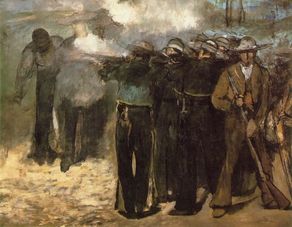Édouard Manet (1832 - 1883)
When Manet was young, his parents decided he would begin a career in the navy, but Manet knew he wanted to be a painter. He started by studying in the studio of Thomas Courture at age 18. Manet had success in his paintings, but unfortunately, in 1859 one of his paintings (The Absinthe Drinker) was rejected from the Salon. Once a painter had a work of art rejected, it was often very difficult to maintain patronage of his art, since it was deemed "bad." Manet's teacher criticized the rejected painting from the Salon, which devastated Manet, who then left the studio. Even though the Salon had rejected a painting of Manet's, he had success in 1861 when two of his paintings were accepted.
Manet was a pivotal figure between the Realism and Impressionist movements. His later paintings more closely depict the Impressionism style. The general style of Manet was the use of color in dark and light extremes. His forms usually appeared flat. Part of the time, Manet painted with the traditional styles of careful detail. Other times, he incorporated sections of paintings with the quick brush style (more characteristic of Impressionism).
Interestingly, Manet used his paintings to depict his feelings about global matters, especially war. These paintings were Manet's "response to modern life," and some scholars deem these as "history painting." For example, Manet painted of a sea skirmish near France from the American Civil War (Battle of the Kearsarge and Alabama, 1864) and also of France's intervention in Mexico. The Execution of Emperor Maximilian, 1867, was Manet's response to French domestic and foreign policy. In the painting is depicted a firing squad executing the Hapsburg emperor.
Manet was a pivotal figure between the Realism and Impressionist movements. His later paintings more closely depict the Impressionism style. The general style of Manet was the use of color in dark and light extremes. His forms usually appeared flat. Part of the time, Manet painted with the traditional styles of careful detail. Other times, he incorporated sections of paintings with the quick brush style (more characteristic of Impressionism).
Interestingly, Manet used his paintings to depict his feelings about global matters, especially war. These paintings were Manet's "response to modern life," and some scholars deem these as "history painting." For example, Manet painted of a sea skirmish near France from the American Civil War (Battle of the Kearsarge and Alabama, 1864) and also of France's intervention in Mexico. The Execution of Emperor Maximilian, 1867, was Manet's response to French domestic and foreign policy. In the painting is depicted a firing squad executing the Hapsburg emperor.
Manet also depicted social scenes through his painting. Cafe's were the social life of Paris in the 19th century. The Cafe Concert (1878) depicts a wealthy gentleman at a bar with other figures around him, including a woman to the left and a waitress in the background. Many French-men gathered in these cafe's for news, discussion, and entertainment. This painting makes good use of the characteristic Impressionist brush-strokes, as well as the bold of the time, such as in the woman's hat.


